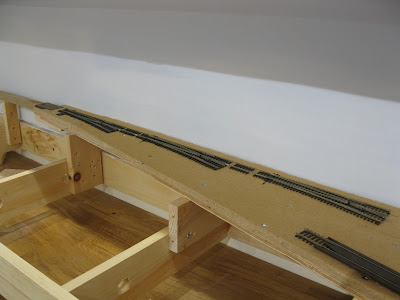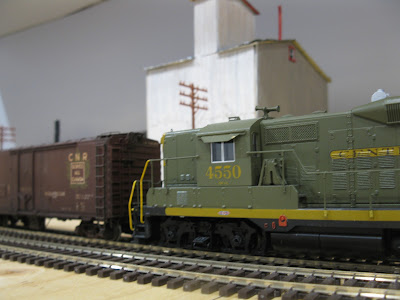People that know me well will probably tell you I'm lacking in the department of constant effort. I will generally pick up a project, work on it like crazy without counting hours then let it rot until a new shiny thing appear. While I will circle back to that project someday, it doesn't make for a very satisfying work ethic as thing looks promising at first then die off after a while. The strange thing is that I always cycle through my different passions and hobbies in the same way.
 |
| Gluing splines is simple, yet a relaxing process... |
All my life, I've followed that manic-depressive way... to the point close friends can tell exactly the moment I'll start working on something and when I will stop... abruptly. It seems that to fight that tendency and get things done, I've developed a habit of trying to get everything done as fast as possible before I lose interest. It generally means accumulating all the stuff and material I need to get the job done and focus only on that thing. For small projects, that intensive way can yield impressive results. Generally, I will be able to work on three projects in a row until I got both tired and, understandably, burned out!
For Monk Subdivision, I tried that recipe once again, believing that having some friends to help me would help the project to reach a reasonable level of completion from which I could no longer back off... Well, so untrue! You can't count on others to fill the gaps when their schedule isn't as flexible as yours... and many things must be done at slow pace to control both quality and learn new techniques. That can't be done on the fly.
 |
| Little by little, day by day, the layout comes to life |
About two months ago, I started to get angry at the lack of progress. I just wanted to run train on what is a twice around. I didn't care about prototype since it's not the end goal and I explained it on this blog. Meanwhile, I was terrorized to try new techniques like MDF spline roadbed or motorize turnout controls. Worst, I couldn't decide on a staging yard plan. Talking with friends helped to rationalize the track plan and made hard decisions, but things weren't moving because nobody was building the layout for me and I quickly discovered you can't build splines in one day... Something had to change... and it was me.
I counted the number of hours I could lose behind the computer screen trying to make the track plan perfect and tweak the scenery... it was astounding. I could have built the layout completely just using these dozens of hours lost because I thought moving pixels could give real answers. You may not know, but I've reached track plan #92 for Monk Subdivision... we are talking about 6 visible turnouts, a mainline and a passing siding. Then, I counted all these wasted hours... 20 minutes here watching an online video before supper, another 30 minutes here because I felt it was not long enough to start working on the layout. At the end of the week, these numbers were mind numbing. I'm not even a social media junky nor own a cellphone yet I was a slave of the web, i.e., I filled every moments I thought "too short" with useless passivity. Then I got really angry and stopped doing these things as much as I could.
 |
| Soldering a few turnouts after work is another small step |
First, I discovered my days felt longer when I was not behind a screen. I seriously think time goes faster when consuming data than doing real things. My personal experience seems to indicate times runs about thrice faster. For any adult in the room here, we all know time goes faster as we age... well, now add that 3x factor and you're about to see you life pass by you at light speed.
Second, I saw someone dismantling a huge collection recently. It was accumulated over 30 years for the big dream layout after retirement... Health issues, unexpected moving and other reasons destroyed that dream... The layout should have been built 30 years ago... smaller, clumsier, but improved upon.
 |
| Splines make sense when new scenes start to take shape |
Third, I remembered Mike Confalone's clumsy but authentic words, that he was unskilled, never planned correctly what he had to do and preferred to make mistakes, correct then and at least move forward. Anybody remotely knowledgeable about Mike's work knows he's accomplished in what he does. If a perfectionist like me who draws precise plans can't do the same, something is wrong. And from that point, I started to think I was better to cut wood, make mistakes and correct them than sit in my armchair.
But that meant a change in my ethics. If you make room for making mistakes, you must also accept things will take time and won't be efficient. Working in intense sessions, expecting perfect results, won't cut it. I knew a lot of unskilled modellers did build more than decent layout, so why should I be afraid.
From that point on, I started to work on the layout in bouts of 30 minutes here, 20 minutes there, sometimes the best part of an evening or a Saturday morning. I had no time limit, just using what was required to reach decent goals and feel the few minutes invested brought me to somewhere meaningful.
 |
| Little is needed to make the magic happens... |
And I made a lot of mistakes... I first screwed the staging yard plywood directly on the frame only yo discover later it was too low and hard to access. It was frustrating, but I put down the tools, went to do something else, knowing next time I would unscrew everything and raise it to the correct height. Later, when I installed wooden risers for the MDF spline, I found out I didn't know what I was doing. They were too short due to miscalculation and wobbly. Once again, it wasn't fun, but calmly I assessed the issue and worked on it the next day. Surprisingly enough, fixing mistakes was faster than I thought and it helped me to learn better ways to do this peculiar job.
Another thing I changed is that when I meet a road block and felt I no longer knew how to fix an issue, I didn't walk away. I took some time to access what was wrong. In the past, I would have left the room, dejected, trying to overplan and overthing the problem in hope to find a magic answer. This time, if I knew I had still some time available, I would do something else to make sure the project wasn't stalled. It could be installing fiberboard in the staging yard, screwing a few risers or gluing some MDFC splines. The goal was to stay active and make sure the project was moving forward. If tasks were to hard to figure out in one shot, I simply broke them in very, very small parts that could be completed fast so I could claim victory at the end of the day.
 |
| Closer to the original vision from sketches |
I've been working that way for two months now and I'm surprised how things have progressed on all front. Changing my work ethic made it possible at a more healthy and satisfying pace. Also, I know I will be able to run trains before I retire. If the layout end up not being satisfying, no problem... I will have learned much more building this one. I may hate Tortoise switch machines, but at least I will have wired some, including dreaded live frogs. Not so long ago, each time I would have hit a serious wall, it would have been a good reason to switch my attention to another project. This is no longer the case.
Working on a layout is a leap of faith. You plan as best as you can and wish it will work. Like any plans, reality hits and you have to adjust. The moment you know that and that your objectives are clear, there is no longer stress moving forward and adjusting as you go. I'll be honest though, I've had more than one moment in the last two months when I felt issues I met were quite though to figure out. Doubts take control and abandoning the mermaid call to work on another project can be very strong. I'm glad to have soldiered on because I know track laying will soon happen and maybe, just maybe, trains will start to run on Monk Subdivision before summer.
In so many ways, this work is about who we become rather than what we accumulate.
ReplyDeleteI think you said it perfectly with so little words.
DeleteThere's a great deal of my own approach in your description of your prior habits. I also need to start doing and learning more.
ReplyDeleteI suspect we are many to share these habits... All born of good intentions, yet leading to very little results. Step by step, things shape up!
DeleteMatt,
ReplyDeleteBullseye! You got the answer! Take your time,
do not panic, work with very short term project, be good with you and respect your personal capacity... Make sure to become fed up! Personnaly, I'm not able to do more than 60 minutes session...I break everything!
Matthieu, you sound entirely like me with projects, when the wind is in my sails, things can go incredibly fast, when I am not feeling it or some other shiny thing distracts me, things can sit for months. I have projects I’ve finished in a week, and buildings I’ve been working on for over a year on the layout. I find you have to just be ready to roll with it. Having seen your work, I know when it gets done, it’s fabulous.
ReplyDeleteStephen
Birds of a feather... isn't it! I guess it's why we call it a passion. It comes in intense bursts. It's a matter of finding a balance. If I hit a wall, I take a break, but will come back in the next few days instead of turning back. It gives a sense of progress. BTW, you have made so much progress with the layout since our last meetings. I'm amazed to see these archive pictures taking shape in real life.
Delete